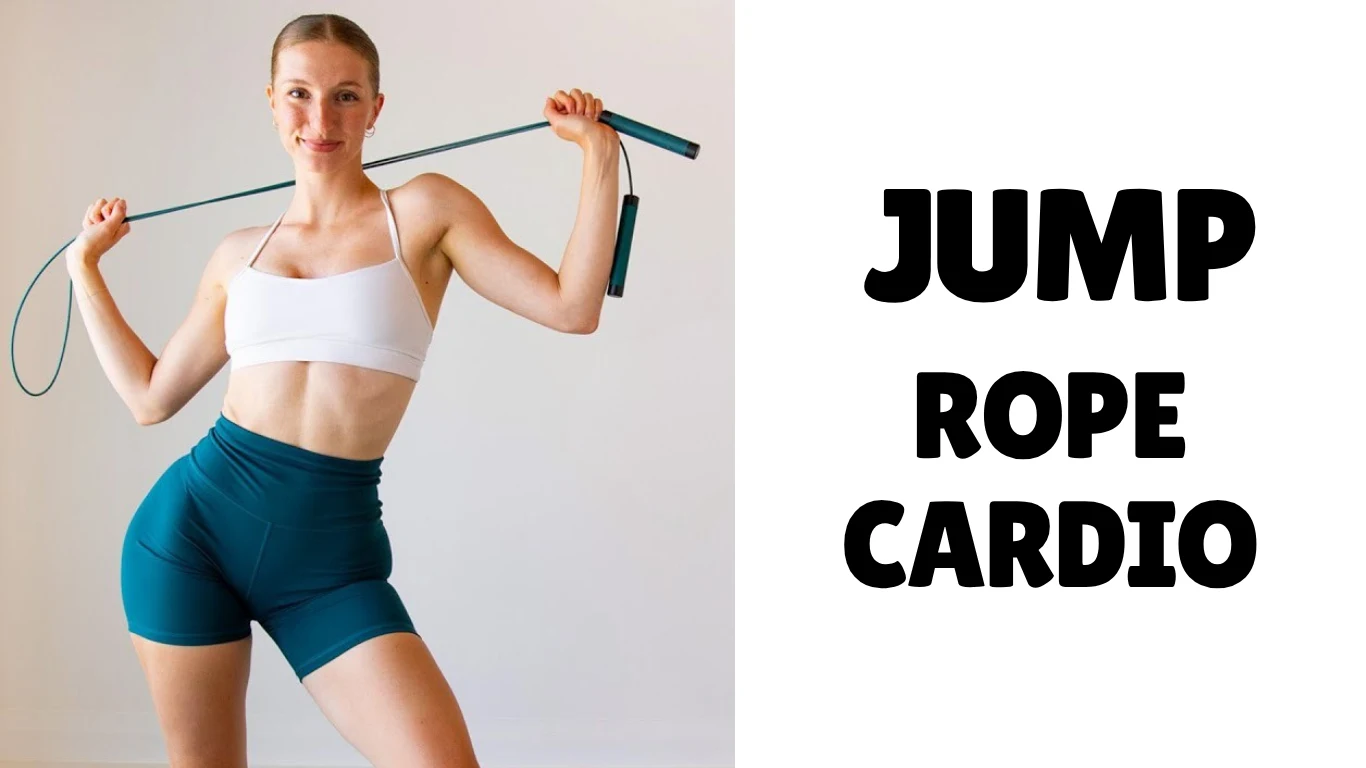Summary
Jump Rope Cardio exercise is one great way to burn off fat and enhance agility. A sequence of muscle groups with progressive endurance, the strenuous exercise burns calories. It works on developing muscular tone particularly in the legs, abdominal area, arms, and shoulders. For sports performance, jump rope also improves coordination, balance, and foot speed—skills essential to Starting short sessions and progressing with gradual increases in intensity will allow beginners to thrive. Alternatives such as side-to—side hops and high knees can be used to also maximize results. With its impact on cardiovascular fitness and endurance, jump rope training increases fat loss and fitness. Steer clear of typical pitfalls such as incorrect rope length or poor posture to enable jump rope to provide injury-free, effective training.
Introduction
Simple yet extremely effective Jump Rope Cardio that will burn fat, raise endurance, and boost overall agility is jump rope exercises. This body-wide exercise engages several muscle groups independent of experience level, so it builds fitness levels rapidly. Jump rope exercises enhance stamina, coordination, and strength as well as cardiovascular health. For individuals seeking to achieve their fitness objectives, jump rope exercise is a readily accessible and affordably priced option with minimal equipment needed and autonomy to be practiced anywhere. The various benefits of jump rope exercises and maximizing your training regimen will be explored on this website.
Jump Rope Benefits for Fat Loss and Agility
Jump rope is one of the best fat burning and sport performance improvement techniques. Learning about the advantages of jump rope for burning fat will help you, regardless of experience level, maximize your cardio workout. By helping you burn excess fat, this inexpensive piece of equipment has a workout for overall body strengthening of endurance, agility, and coordination.
Jumping rope is an effective form of aerobic exercise.
One rigorous, calorie-burning activity that involves several muscle groups simultaneously is rope jumping. It rapidly raises one’s heart rate and, therefore, burns a larger number of calories in a shorter duration compared to walking or running.
High-intensity activities such as jump rope boost your metabolism so that your body will continue to burn calories long after the activity has stopped. When combined with healthy diet and regular training, this “afterburn” effect speeds fat loss.
Muscles Involved in Jump Rope
The other major reason why jump rope is effective in burning fat is because it involves the entire body. Glutes, calves, thighs, arms, shoulders, and core are all involved when you are jumping. This not only provides muscle endurance but more muscle tone also, ultimately increasing the efficiency of training.
Activating your stomach muscles and assisting with improved posture also results from utilizing your core to stabilize.
Agility Training and Jump Rope
Jump Rope Cardio improves foot speed, balance, and rhythm. Important aspects of agility, they are prevalent in numerous sports and daily activity. The repetitive nature of this activity enables your body to react fast and keep its feet light, so it is a great way to improve coordination and overall athleticism.
Minor adjustments such as double-unders, high knees, or side-to-side hops add to the workout and optimize agility development.
How Frequently to Jump Rope to See Results
Jump rope training can be performed three to five times a week for fat loss, beginning with short intervals and increasing in duration over a time period. More prolonged endurance-based regimens or short HIIT-style regimens both reduce fat and improve levels of fitness. Particularly when agility and fat loss are your main goals, jump rope training is effective, comparatively inexpensive, and versatile to almost any fitness level.
Beginner Jump Rope Cardio Workout for Quick Results
One simple and efficient way to increase your fitness level is starting a jump rope program. With only a rope and a small space, you can build endurance, burn fat, and increase heart rate. Regardless of your inexperience with exercising, this starting jump rope cardio program is designed to provide benefits in a short time.
Why Begin with the Jump Rope?
Jump rope exercises are quite efficient and conveniently available. They train your arms, stomach, shoulders, and legs as they shar their timing and synchronization. Beginning beginners, jump rope is a means to increase cardiovascular endurance and calorie burning ability.
How to Prepare Yourself for Your First Rope Skipping Routine
- Choose a rope so that when stepped on it only just goes below armpits.
- Wear supportive footwear and jump on a soft surface such as a floor mat or a wooden floor.
- Keeping wrists free and with your elbows close by your body, spin the rope.
Easy Beginner Jump Rope Cardio Workout
Warm-Up (2 minutes)
Starting with modest rope swings or jumping in place, warm up your body and release your joints.
Basic Jump (2 minutes)
Jump in time, feet both at once. Stress gradual motions and little hops.
Rest (30 seconds)
Two-minute alternate-foot jumps
Shadow a jog with a bouncing rope between feet. This reduces impact and improves coordination.
Rest for thirty seconds.
One minute of knee-high jumps.
While jumping, lift knees close to your chest. This exercise conditions your core and heightens intensity.
The Side-to-Side Jump (1
Jump and alternate hopping a bit to the left and to the right. A variation of this movement adds agility and involves several leg muscles.
Cool down (2 minutes
Finish with simple shoulder stretches, hamstring stretches, and calf stretches. Bring your heart rate back to a normal state by walking in place.
Tips for Improvement
Start with three to four times a week short sessions. As stamina builds, progressively add time and speed. Your first jump rope workout program will produce quick noticeable results through emphasizing consistency over perfection.
Best Jump Rope Cardio Techniques to Boost Coordination
Training with jump rope goes beyond simple aerobic activity. This is a great instrument for help with rhythm, balance, and body control. Learning fundamental jump rope techniques for coordination can improve your whole athletic ability and enable more effective movement in daily life or sports.
Why would Jump Rope Cardio help with coordination?
Time your jumps with every spin in jump ropping. This tests the cooperative ability of your muscles and brain. This improves neuromuscular control over time, therefore enabling more exact and faster movement. Even basic jumps improve hand-eye coordination and footwork.
Basic Techniques to Begin With
Single Bounce
All jump rope movements are based on the single bounce. Take small, quick hops and jump both feet simultaneously. Keeping rope pace consistent, keep your back straight. Timing and rhythm are established from this.
Change Foot Jump
Sometimes referred to as the jog step, this technique mimics running in place. As the rope goes under you jump one foot and then the other. Minimizing impact, it builds foot control and rhythm.
High Knee:
This one introduces a coordination challenge and increases intensity. Maintaining the rope swinging, lift your knees to waist level. Attempt to time the jumps with constant arm movement.
Advanced Coordination Techniques
Side Swings
Swing rope one side of your body without jumping; return to jump. The drill exercises hand coordination and control of rope.
Criss-Cross
In front of the body, on each jump cross your arms, and then uncross. Very good to boost rhythm and concentration, crisscross requires upper-body timing.
Double Unders
Swing the rope underneath your feet twice during every jump. For advanced coordination training, this quick movement is ideal as it requires precise timing and swift action.
Tips for Improvement
Start with three to four times a week short sessions. As stamina builds, progressively add time and speed. Your first jump rope workout program will produce quick noticeable results through emphasizing consistency over perfection.
Jump Rope Cardio HIIT: Fast Fat-Burning Home Workout
Effective, quick, and simple jump rope workouts are well established. Together with high-intensity interval training (HIIT), they form a powerful tool for endurance and fat burn. Ideal for home use, the jump rope HIIT for fat burn workout requires minimal space and yields excellent results within a short time frame.
Why HIIT Works for Fat Burn
HIIT is based on rapid intervals of high-intensity exercise with rest in between. This method maximizes calorie burn, increases heart rate, and optimizes metabolic function. The best tool for HIIT is a jump rope because it easily boosts your intensity without needing to set up complicated settings.
Advantages of Jump Rope HIIT
- increases fat burning after and during your workout.
- improves cardiac endurance and power.
- Builds muscle tone—particularly in the legs, core, and shoulders.
- Compact sessions with high return on investment.
15 Minutes Sample HIIT Rope Jump Routine
Warm-Up (2 minutes)
Warm up by light jumping rope or in place running.
intervals of work (Do all thirty seconds at a time, rest fifteen between sets).
Easy Jump
Using fast, small hops, jump both feet.
High knees
Jumping, bring knees toward your chest.
Criss-crossing
Every few jumps, cross arms at the wrist; then, uncross.
Side to-side jumps
While jumping rope, hop a little left and right.
Double Unders (Advanced)
Twice per jump, swing the rope underneath your feet.
Depending on your level of fitness, repeat this entire circuit two to three times.
Cool Down (2 minutes)
Stretch shoulders, thighs, and calf muscles. March or walk in place to decrease heart rate.
Tips for Better Results
Keep your wrists loose and ensure your jumps close to the ground to allow for quicker rope turns. Prioritize form above speed. As fitness builds, either reduce rest time or do more rounds. This fat burn jump rope HIIT program will assist in maintaining steady weight loss and improving in fitness three to five times a week.
How Long Should You Jump Rope Cardio?
One speedy and wonderful method of enhancing your overall fitness and cardiac health is jumping rope. This handy, portable, and easily mastered tool is one of the most ideal tools for home or anywhere cardio workouts. With the right jump rope length for cardio, you’ll be able to optimize results while avoiding overtraining.
Ideal Jump Rope Cardio Based on Your Objective
Your level of fitness and what you want to achieve will dictate how long you jump rope. While experienced users can get through longer or more strenuous intervals, new users can begin with short sessions.
For Beginners
Begin with five to ten minutes of jumping split into brief rounds. This reduces risk of injury and continually builds endurance. Your heartbeat will rise and coordination will also get better with just a couple of minutes daily.
For Weight Loss
The For optimal fat burning, jump rope for fifteen to thirty minutes. To burn calories maximally and support fat loss, this can be performed in intervals, fast and slow rounds alternately.
There For Endurance and Heart Health
Attempt twenty to forty minutes of repeated jumping for cardiovascular stamina. To make it more stimulating, incorporate in variations like side-to—side hops or high knees. In case of a need, divide the time into manageable sets.
Utilizing Intervals to Enhance Efficiency
Brief jump rope exercises take great advantage of HIIT-style workouts’ effectiveness. For example, jump rapidly for thirty seconds at a high intensity, then rest for fifteen seconds and repeat. This method elevates your metabolism after your activity has ceased and keeps your heart rate elevated.
How Often to Jump Rope for Cardio
Three to five times a week based on your goals, jump rope. Rest days determine recovery and making progress over time. Your cardio jump rope length can be extended with ease as your endurance increases.
Tips for Better Sessions
- Having low and steady leaps is aided
- Get supportive footwear and a suitable-length rope.
- Warm up always before starting; cool down with stretches when you’re finished.
- Varying your time and rate can make jump rope a useful and effective aerobic aid.
Weighted vs Speed Ropes: Which Is Better for Cardio?
Your conditioning would be better improved with choosing the proper jump rope. With weighted compared to speed jump rope cardio, each has specific strengths. The significant differences are itemized in the following table to inform your decision about which best serves your exercise needs.Jump Rope Cardio
| Feature | Weighted Jumble Rope | Fast Jump Rope |
| Primary Benefit | Builds strength and endurance | increases rapid footwork, speed, and agility. |
| Best For | Muscle activation and full-body exercises | High-intensity cardio, coordination development |
| Cardio Intensity | Moderate to high (slower tempo) | High—more hops per minute, faster speed |
| Muscle Engagement | Greater (core, shoulders, arms) | Less, more on rhythm and timing |
| Calorie Burn | Higher with time because of opposition. | Quick calorie burning with shorter sessions |
| Learning Curve | Slower, better for under control jumping | Faster, better for seasoned users |
| Fatigue Level | Gets fast with prolonged usage. | lets you have longer cardio sessions. |
| Durability | Often more robust, heavier constructions | Lightweight, can fade more quickly on uneven ground |
| Best Use Case | Cardio combination with strength cards and interval trainingWeighted Jumble Rope | Endurance or HIIT, fast-paced cardio, |
Jump Rope Cardio for Endurance and Stamina
Not just for short exercise or caloric burn is jump rope. One of the best ways to build cardiovascular endurance and sustainable energy is also Ideal for athletes, runners, and everyone focused on fitness longevity, a specific jump rope exercise for endurance will increase how long and how hard you can train without fatigating.
Why Use Jump Rope to Build Endurance?
Jumping rope exercises your heart, lungs, and muscles simultaneously. It tightens up your shoulders, legs, and core and accelerates your heartbeat. It builds endurance by making your body more capable of handling longer sessions of physical exertion with diminishing fatigue over the long term.
Important Factors of an Endurance-Based Jump Rope Cardio Workout
Longer Workouts at a Continuous Pace
Leap for extended periods using sustained rhythm to build endurance. Begin in short sets and gradually increase your time over time. Attempt intervals of three to five minutes of uninterrupted hopping alternately with short breaks.
Use Light Footwork
Keep your footing light and low jumps. This reduces strain and maintains power during longer workouts. Practice breathing through both your mouth and nose.
Make Basic and Alternate Steps
Put alternately foot hops together with basic bounce steps. Such adjustments make exercise fun and involve multiple muscles, thus allowing you to work out longer without becoming exhausted.
Progressive Overload
Allow your overall jump length a bit additional time every week. Central to increases in endurance, this method allows the body to acclimate progressively.
Example Jump Rope Workout for Endurance
- Two to three minutes of moderate leaping will prepare you.
- With one-minute rests, perform three repetitions of five-minute steady jumps.
- Challenge coordination by utilizing variations such as side-to—side hops or high knees.
- Hamstring, quad, and calf stretching cools you down.
A jump rope endurance routine continually hones body and mind. Your breathing, recovery time, and overall energy during regular activities and exercise will all improve as your endurance increases.
Conclusion
You can improve your coordination, lose fat, and boost your cardiovascular fitness by doing a jump rope workout, and it is a great and very effective method of doing all these all at the same time. Adding Jump Rope Cardio to your routine will allow you to witness great development in any area of your body, irrespective of whether or not your goal is to become leaner, enhance your endurance, or become more physically agile. In a matter of minutes, you can have dazzling results by focusing on good technique, gradual increases in intensity, and regularity. Anyone attempting to boost their fitness level at home or on the go will find jump rope the best choice because it is so affordable and its applications are limitless. Keep challenging yourself; this easy but effective exercise will continue to reward you.
FAQ’s
For your level of fitness, do 15 to 30 minutes of jump rope for fat loss. To enhance the burn of calories, divide it into intervals with alternating high-low intensity.
In fact, for beginners jump rope is quite good. Begin with brief workouts and easy jumps or alternate-foot jumps with basic form. Your endurance will increase, enabling you to increase the intensity and duration of work.
By having your jumps coincide with every rope rotation, jump rope actually improves coordination. It works your lower and upper body, so timing, rhythm, and balance all improve.
Jump rope three to five times a week if you want benefits to show. Begin with shorter sessions and gradually increase the duration and intensity as your fitness improves.






